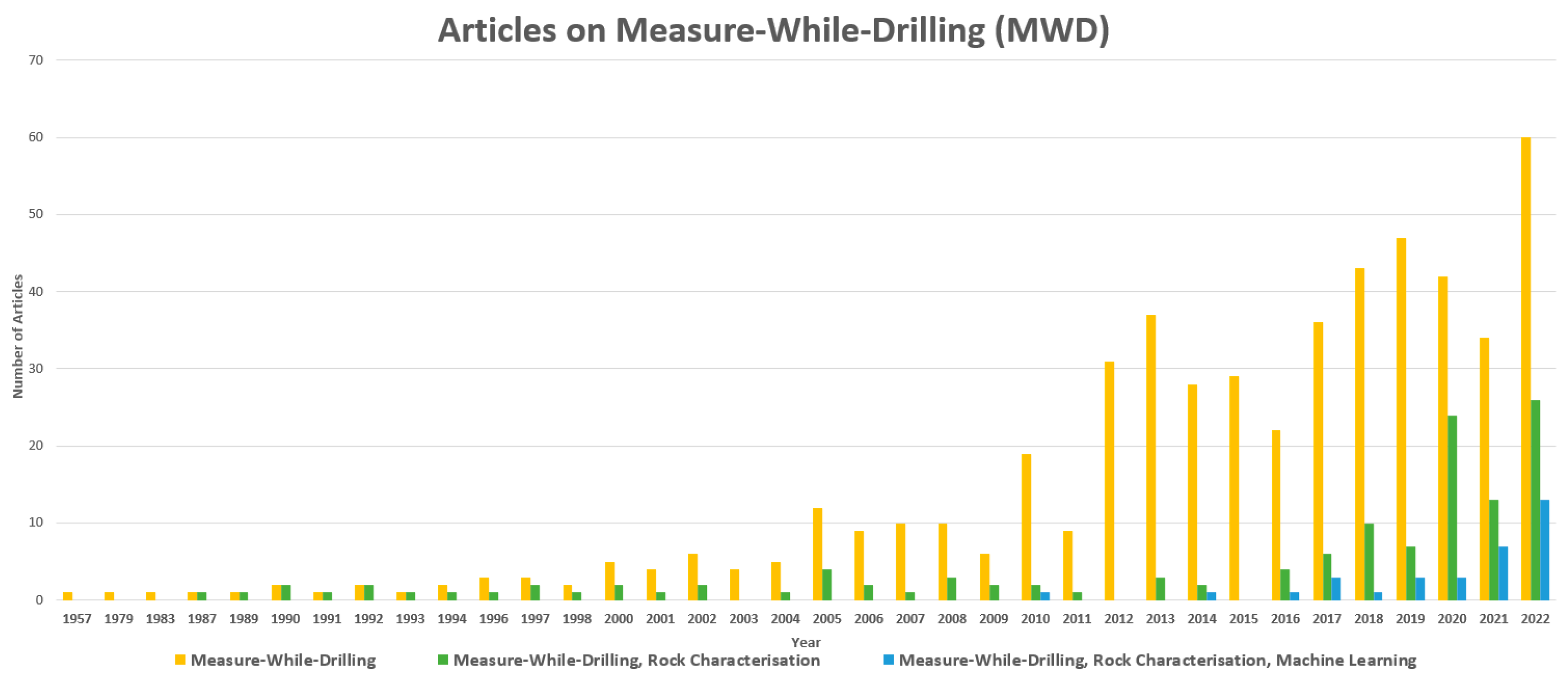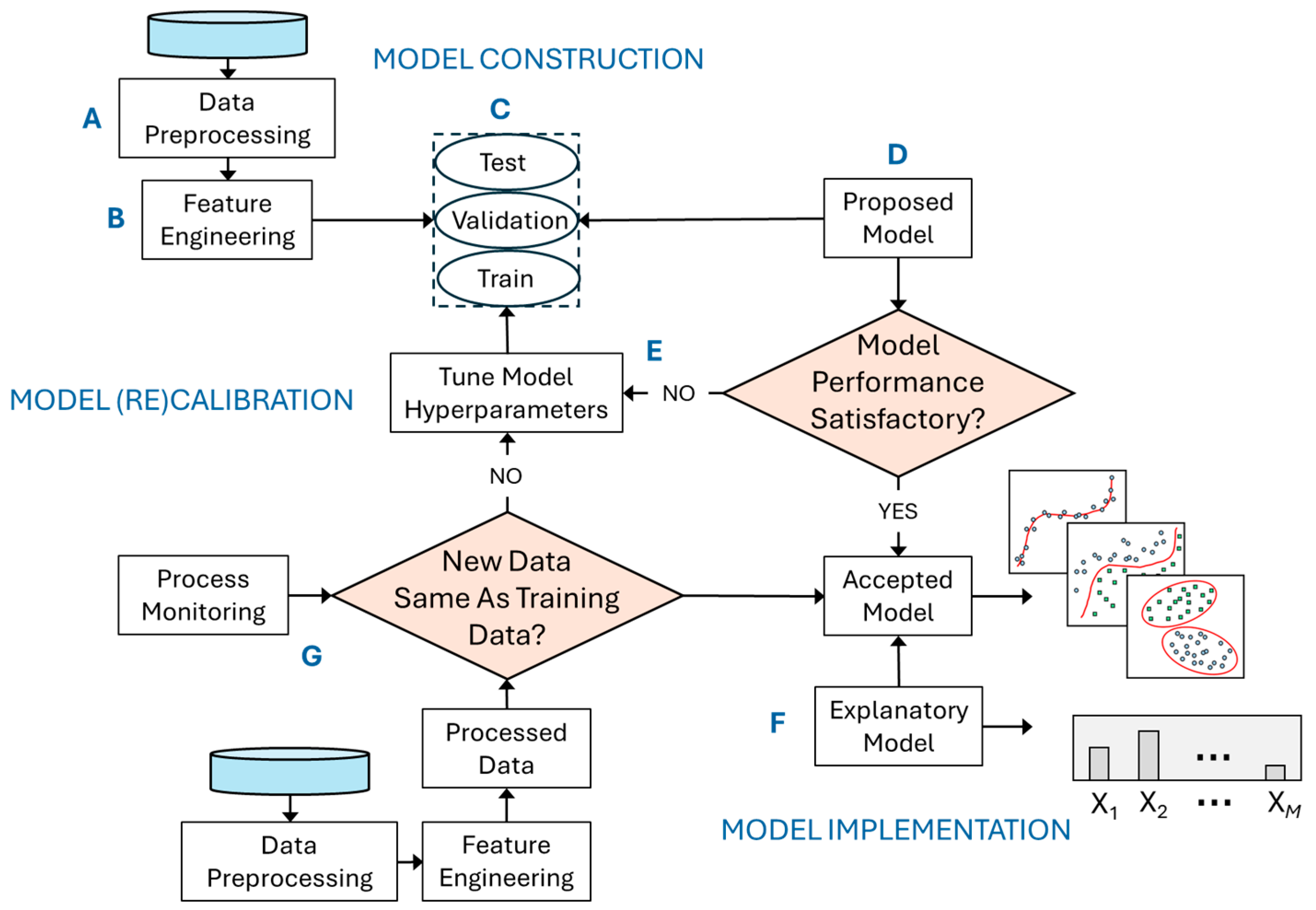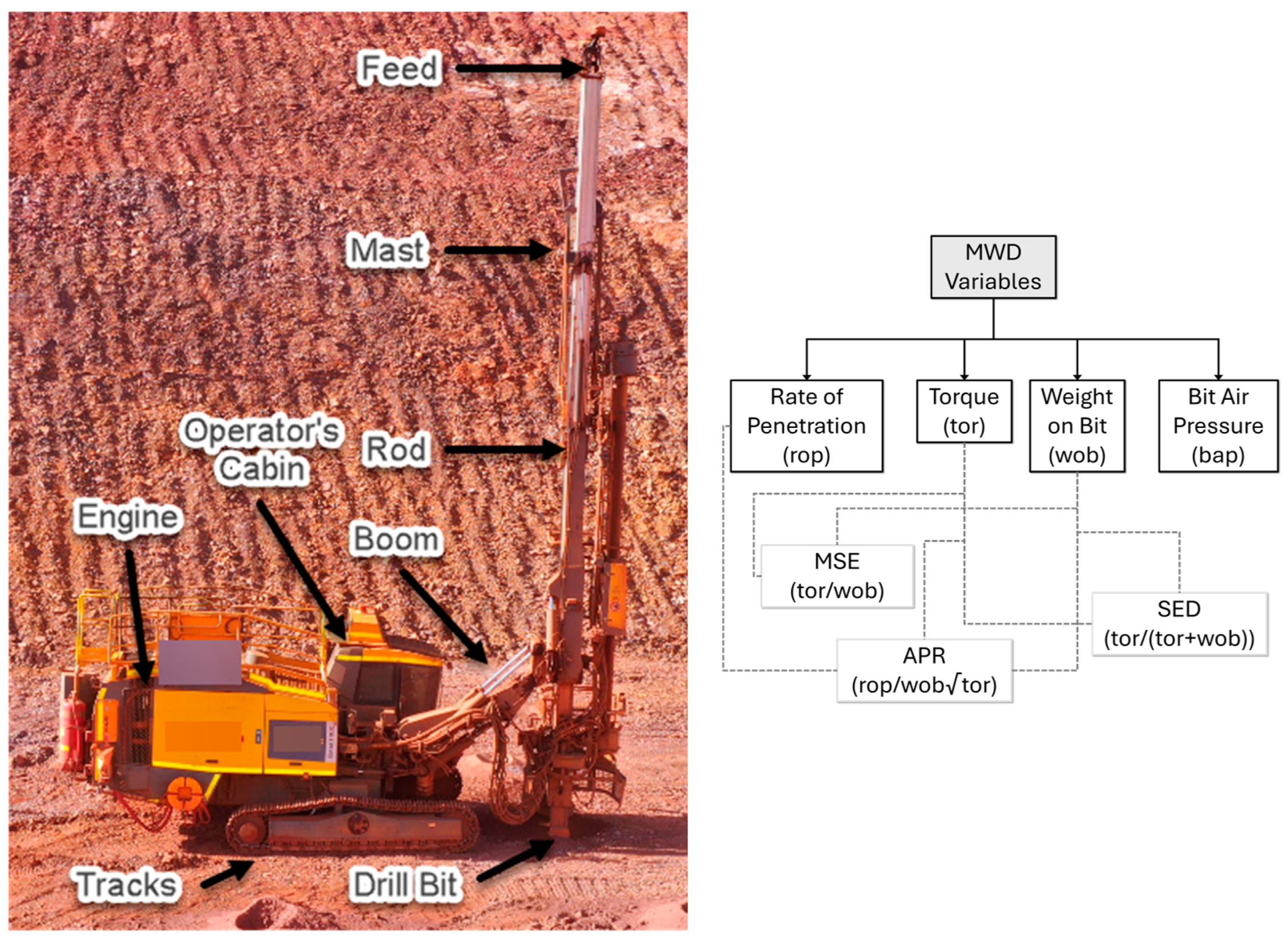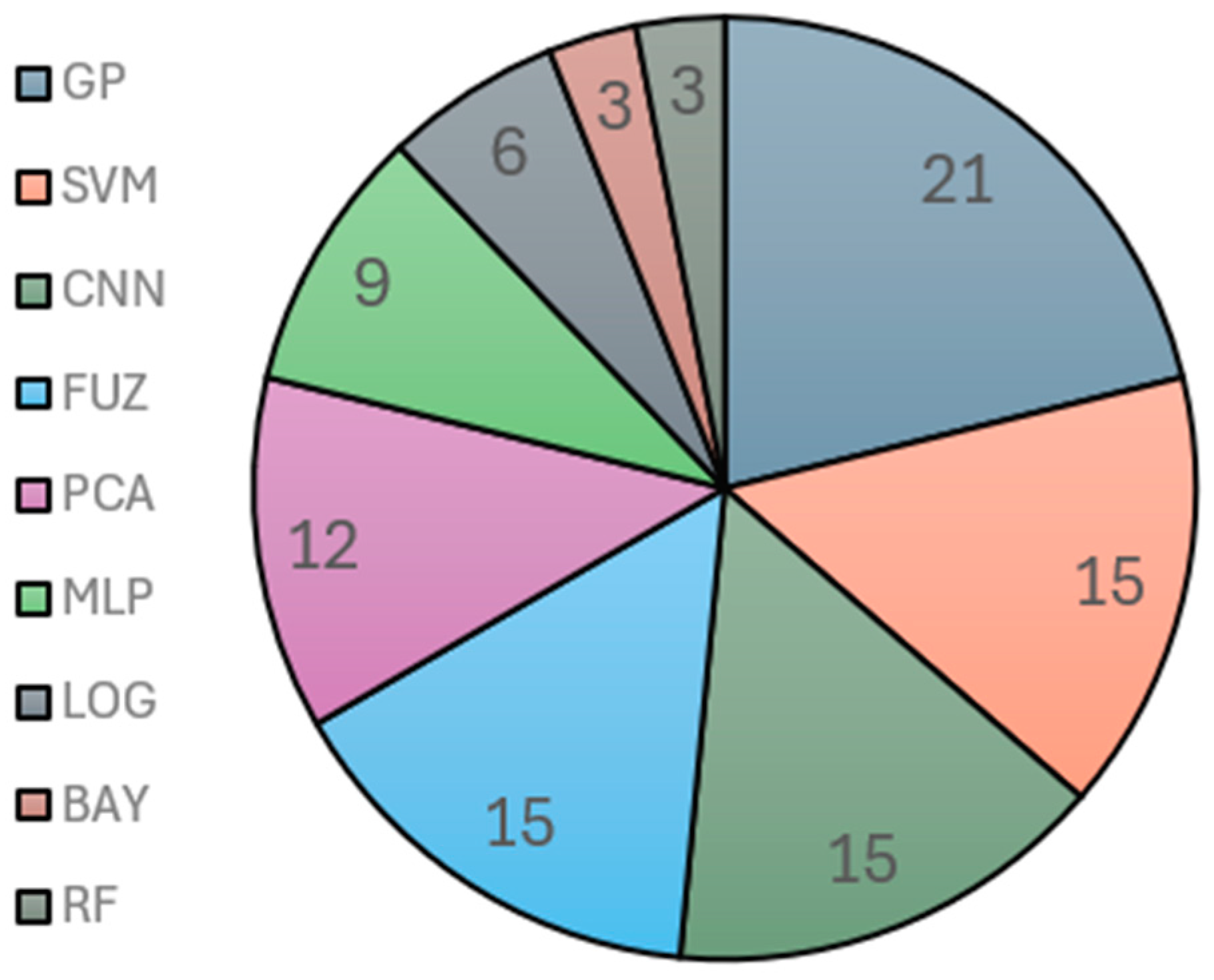A Review of Orebody Knowledge Enhancement Using Machine Learning on Open-Pit Mine Measure-While-Drilling Data
Abstract
1. Introduction
2. Literature Sources and Dissemination
3. Development of Machine Learning Models from MWD Data
4. Practical Applications
4.1. Geology Recognition from MWD
4.1.1. Mined Commodities
4.1.2. MWD Metrics
4.1.3. Machine Learning Classification
4.2. Rock Mass Properties from MWD
4.2.1. Commodities
4.2.2. Feature Importance
4.2.3. Machine Learning Classification
4.3. Geochemical Properties from MWD
5. Discussion
5.1. Current Challenges
5.2. Future Developments
6. Conclusions
- The most commonly measured MWD variables measured together with the depth of drilling in open-pit mines are rate of penetration (rop), torque or rotational pressure (tor), bit air pressure (bap), weight on bit (wob), and rotary speed or revolutions per minute (rpm).
- Several studies have analysed the relative importance of each of these variables related to the identification of rock types and characteristics with mixed results. This is an emerging area that can benefit from recent significant advances in machine learning, where models are interpreted or explained. This would particularly be the case where other MWD variables, such as image, vibrational or acoustic signals are included in models.
- In most studies, ML models could successfully categorize geological zones or rock types from MWD data, but further work is required to capture more subtle differences within geological units.
- Classification of discrete rock mass properties, including rock strength and fracture count, using ML methods on open-pit blast hole MWD data does not appear to have been demonstrated yet. Instead, rock type is typically identified as a proxy for rock strength based on assumptions associated with each type.
- Only one study considered the prediction of geochemical properties using ML classification on MWD and drill cutting assay datasets. ML analytical methods applied to MWD data resulting in discrete values for geotechnical, geological, and geochemical will enable a low-cost, high-resolution comprehension of subsurface conditions beyond simple rock type classification.
- Overall, these studies have not yet taken full advantage of recent developments in deep learning and, as more data are collected, these ML approaches are likely to play a more important role in MWD data analysis for enhanced comprehension of geology, rock mass characteristics, and ore attributes for enhanced sustainability, efficiency, and safety of mining operations.
Author Contributions
Funding
Acknowledgments
Conflicts of Interest
References
- Segui, J.B.; Higgins, M. Blast Design Using Measurement While Drilling Parameters; Australasian Institute of Mining and Metallurgy: Melbourne, Australia, 2001; pp. 28–31. [Google Scholar]
- Barr, M.V. Instrumented Horizontal Drilling for Tunnelling Site Investigation. Ph.D. Thesis, University of London: Imperial College of Science and Technology, London, UK, 1984. [Google Scholar]
- Barr, M.V.; Brown, E.T. A Site Exploration Trial Using Instrumented Horizontal Drilling. In Proceedings of the 5th ISRM Congress, Melbourne, Australia, 10–15 April 1983; International Soceity of Rock Mechanics: Lisbon, Portugal, 1983; pp. 51–58. [Google Scholar]
- Brown, E.T.; Barr, M.V. Instrumented Drilling as an Aid to Site Investigations. In Proceedings of the 3rd International Congress of the International Association of Engineering Geology, Madrid, Spain, 4–8 September 1978; pp. 21–28. [Google Scholar]
- Leighton, J.C. Development of a Correlation between Rotary Drill Performance and Controlled Blasting Powder Factors. Master’s Thesis, University of British Columbia, Vancouver, BC, Canada, 1982. [Google Scholar]
- Scoble, M.J.; Peck, J. A Technique for Ground Characterization Using Automated Production Drill Monitoring. Int. J. Surf. Min. Reclam. Environ. 1987, 1, 41–54. [Google Scholar] [CrossRef]
- Scoble, M.J.; Peck, J.; Hendricks, C. Correlation between Rotary Drill Performance Parameters and Borehole Geophysical Logging. Min. Sci. Technol. 1989, 8, 301–312. [Google Scholar] [CrossRef]
- Silversides, K.L.; Melkumyan, A. Boundary Identification and Surface Updates Using MWD. Math. Geosci. 2020, 53, 1047–1071. [Google Scholar] [CrossRef]
- Basarir, H.; Wesseloo, J.; Karrech, A.; Pasternak, E.; Dyskin, A. The Use of Soft Computing Methods for the Prediction of Rock Properties Based on Measurement While Drilling Data. In Deep Mining 2017: Proceedings of the Eighth International Conference on Deep and High Stress Mining; Australian Centre for Geomechanics: Perth, Australia, 2017; pp. 537–551. [Google Scholar] [CrossRef]
- Lucifora, D.J.; Rafezi, H. State of the Art Review: Monitoring-While-Drilling for Mining Applications. In Proceedings of the World Mining Congress (WMC), Montreal, QC, Canada, 11–15 August 2013; Volume 4. [Google Scholar]
- Silversides, K.L.; Ball, A.; Melkumyan, A. BIF-Hosted Deposit Unit Differentiation Using Multivariate Gaussian Processes on Measure While Drilling Data. Appl. Earth Sci. 2020, 129, 164–175. [Google Scholar] [CrossRef]
- Beattie, N. Monitoring-While-Drilling for Open-Pit Mining in a Hard Rock Environment. Master’s Thesis, Queen’s University, Kingston, ON, Canada, 2009. [Google Scholar]
- Ghosh, R. Assessment of Rock Mass Quality and Its Effects on Chargeability Using Drill Monitoring Technique. Ph.D. Thesis, Lulea University of Technology, Luleå, Sweden, 2017. [Google Scholar]
- Khorzoughi, M.B. Use of Measurement While Drilling Techniques for Improved Rock Mass Characterization in Open-Pit Mines. Master’s Thesis, University of British Columbia, Vancouver, BC, Canada, 2011. [Google Scholar]
- Liu, J. Study on Intelligent Prediction Models of Geological Conditions ahead of Tunnel Face Using Measurement-While-Drilling Data. Ph.D. Thesis, Nagasaki University, Nagasaki, Japan, 2021. [Google Scholar]
- Martin, J. Application of Pattern Recognition Techniques to Monitoring-While-Drilling on a Rotary Electric Blasthole Drill at an Open-Pit Coal Mine. Master’s Thesis, Queen’s University, Kingston, ON, Canada, 2007. [Google Scholar]
- Navarro Miguel, J. The Use of Measure While Drilling for Rock Mass Characterization and Damage Assessment in Blasting. Ph.D. Thesis, Universidad Politechnica de Madrid, Madrid, Spain, 2018. [Google Scholar]
- Leung, R.; Scheding, S. Automated Coal Seam Detection Using a Modulated Specific Energy Measure in a Monitor-While-Drilling Context. Int. J. Rock Mech. Min. Sci. 2015, 75, 196–209. [Google Scholar] [CrossRef]
- Zhong, R.; Johnson, R.L.; Chen, Z. Using Machine Learning Methods to Identify Coals from Drilling and Logging-While-Drilling LWD Data. In Asia Pacific Unconventional Resources Technology Conference, Brisbane, Australia, 18–19 November 2019; Society of Petroleum Engineers: Richardson, TX, USA, 2019. [Google Scholar] [CrossRef]
- Kadkhodaie-Ilkhchi, A.; Monteiro, S.T.; Ramos, F.; Hatherly, P. Rock Recognition from MWD Data: A Comparative Study of Boosting, Neural Networks, and Fuzzy Logic. IEEE Geosci. Remote Sens. Lett. 2010, 7, 680–684. [Google Scholar] [CrossRef]
- Zhou, H.; Hatherly, P.; Monteiro, S.T.; Ramos, F.; Oppolzer, F.; Nettleton, E.; Scheding, S. Automatic Rock Recognition from Drilling Performance Data. In Proceedings of the 2012 IEEE International Conference on Robotics and Automation, Saint Paul, MN, USA, 14–18 May 2012; pp. 3407–3412. [Google Scholar] [CrossRef]
- Hatherly, P.; Leung, R.; Scheding, S.; Robinson, D. Drill Monitoring Results Reveal Geological Conditions in Blasthole Drilling. Int. J. Rock Mech. Min. Sci. 2015, 78, 144–154. [Google Scholar] [CrossRef]
- Akyildiz, O.; Basarir, H.; Vezhapparambu, V.S.; Ellefmo, S. MWD Data-Based Marble Quality Class Prediction Models Using ML Algorithms. Math. Geosci. 2023, 55, 1059–1074. [Google Scholar] [CrossRef]
- Khushaba, R.N.; Melkumyan, A.; Hill, A.J. A Machine Learning Approach for Material Type Logging and Chemical Assaying from Autonomous Measure-While-Drilling (MWD) Data. Math. Geosci. 2021, 54, 285–315. [Google Scholar] [CrossRef]
- Navarro, J.; Seidl, T.; Hartlieb, P.; Sanchidrián, J.A.; Segarra, P.; Couceiro, P.; Schimek, P.; Godoy, C. Blastability and Ore Grade Assessment from Drill Monitoring for Open Pit Applications. Rock Mech. Rock Eng. 2021, 54, 3209–3228. [Google Scholar] [CrossRef]
- Vezhapparambu, V.S.; Eidsvik, J.; Ellefmo, S.L. Rock Classification Using Multivariate Analysis of Measurement While Drilling Data: Towards a Better Sampling Strategy. Minerals 2018, 8, 384. [Google Scholar] [CrossRef]
- Ahsan, N.; Scheding, S.; Monteiro, S.T.; Leung, R.; McHugh, C.; Robinson, D. Adaptive Sampling Applied to Blast-Hole Drilling in Surface Mining. Int. J. Rock Mech. Min. Sci. 2015, 75, 244–255. [Google Scholar] [CrossRef]
- Liaghat, S.; Gustafson, A.; Johansson, D.; Schunnesson, H. Ore Grade Prediction Using Informative Features of MWD Data. In Mining Goes Digital, Proceedings of the 39th International Symposium on Application of Computers and Operations Research in the Mineral Industry, APCOM 2019, Wroclaw, Poland, 4–6 June 2019; CRC Press: London, UK, 2019; pp. 226–234. [Google Scholar] [CrossRef]
- Vezhapparambu, V.S.; Ellefmo, S.L. Estimating the Blast Sill Thickness Using Changepoint Analysis of MWD Data. Int. J. Rock Mech. Min. Sci. 2020, 134, 104443. [Google Scholar] [CrossRef]
- Fang, Y.; Wu, Z.; Sheng, Q.; Tang, H.; Liang, D. Tunnel Geology Prediction Using a Neural Network Based on Instrumented Drilling Test. Appl. Sci. 2020, 11, 217. [Google Scholar] [CrossRef]
- van Eldert, J.; Schunnesson, H.; Saiang, D.; Funehag, J. Improved Filtering and Normalizing of Measurement-While-Drilling (MWD) Data in Tunnel Excavation. Tunn. Undergr. Space Technol. 2020, 103, 103467. [Google Scholar] [CrossRef]
- Hjelme, J.G. Drill Parameter Analysis in the Løren Tunnel. Master’s Thesis, University of Oslo: Faculty of Mathematics and Natural Sciences, Oslo, Norway, 2010. [Google Scholar]
- Gupta, I.; Tran, N.; Devegowda, D.; Jayaram, V.; Rai, C.; Sondergeld, C.; Karami, H. Looking Ahead of the Bit Using Surface Drilling and Petrophysical Data: Machine-Learning-Based Real-Time Geosteering in Volve Field. SPE J. 2020, 25, 990–1006. [Google Scholar] [CrossRef]
- Klyuchnikov, N.; Zaytsev, A.; Gruzdev, A.; Ovchinnikov, G.; Antipova, K.; Ismailova, L.; Muravleva, E.; Burnaev, E.; Semenikhin, A.; Cherepanov, A.; et al. Data-Driven Model for the Identification of the Rock Type at a Drilling Bit. J. Pet. Sci. Eng. 2019, 178, 506–516. [Google Scholar] [CrossRef]
- Litvinenko, V.S.; Dvoinikov, M.V. Justification of the Technological Parameters Choice for Well Drilling by Rotary Steerable Systems. PMI 2019, 235, 24–29. [Google Scholar] [CrossRef]
- Romanenkova, E.; Zaytsev, A.; Klyuchnikov, N.; Gruzdev, A.; Antipova, K.; Ismailova, L.; Burnaev, E.; Semenikhin, A.; Koryabkin, V.; Simon, I.; et al. Real-Time Data-Driven Detection of the Rock-Type Alteration During a Directional Drilling. IEEE Geosci. Remote Sens. Lett. 2020, 17, 1861–1865. [Google Scholar] [CrossRef]
- Finfinger, G.; Peng, S.; Gu, Q.; Wilson, G.; Thomas, B. An Approach to Identifying Geological Properties from Roof Bolter Drilling Parameters. In Proceedings of the 19th International Conference on Ground Control in Mining, Morgantown, WV, USA, 8–10 August 2000; pp. 1–12. [Google Scholar]
- Kahraman, S.; Rostami, J.; Naeimipour, A. Review of Ground Characterization by Using Instrumented Drills for Underground Mining and Construction. Rock Mech. Rock Eng. 2016, 49, 585–602. [Google Scholar] [CrossRef]
- Rostami, J.; Kahraman, S.; Naeimipour, A.; Collins, C. Rock Characterization While Drilling and Application of Roof Bolter Drilling Data for Evaluation of Ground Conditions. J. Rock Mech. Geotech. Eng. 2015, 7, 273–281. [Google Scholar] [CrossRef]
- Utt, W.K. Neural Network Technology for Strata Strength Characterization. In Proceedings of the IJCNN’99. International Joint Conference on Neural Networks. Proceedings (Cat. No.99CH36339), Washington, DC, USA, 10–16 July 1999; IEEE: Washington, DC, USA, 1999; Volume 6, pp. 3806–3809. [Google Scholar]
- Teale, R. The Concept of Specific Energy in Rock Drilling. Int. J. Rock Mech. Min. Sci. 1965, 2, 57–73. [Google Scholar] [CrossRef]
- Wold, S.; Esbensen, K.; Geladi, P. Principal Component Analysis. Chemom. Intell. Lab. Syst. 1987, 2, 37–52. [Google Scholar] [CrossRef]
- Herwig, N.; Borghesani, P. Explaining Deep Neural Networks Processing Raw Diagnostic Signals. Mech. Syst. Signal Process. 2023, 200, 110584. [Google Scholar] [CrossRef]
- Loh, W.-Y.; Zhou, P. Variable Importance Scores. J. Data Sci. 2021, 19, 569–592. [Google Scholar] [CrossRef]
- Wei, P.; Lu, Z.; Song, J. Variable Importance Analysis: A Comprehensive Review. Reliab. Eng. Syst. Saf. 2015, 142, 399–432. [Google Scholar] [CrossRef]
- Barton, N.; Lien, R.; Lunde, J. Engineering Classification of Rock Masses for the Design of Tunnel Support. Rock Mech. 1974, 6, 189–236. [Google Scholar] [CrossRef]
- Bieniawski, Z.T. Geomechanics Classification (Rock Mass Rating System). In Engineering Rock Mass Classifications: A Complete Manual for Engineers and Geologists in Mining, Civil, and Petroleum Engineering; Wiley-Interscience: New York, NY, USA, 1989. [Google Scholar]
- Deere, D.U. Technical Description of Rock Cores. Rock Mech. Eng. Geol. 1963, 1, 18–22. [Google Scholar]
- Hoek, E.; Brown, E.T. Practical Estimates of Rock Mass Strength. Int. J. Rock Mech. Min. Sci. 1997, 34, 1165–1186. [Google Scholar] [CrossRef]
- Khorzoughi, M.B.; Hall, R.; Apel, D. Rock Fracture Density Characterization Using Measurement While Drilling (MWD) Techniques. Int. J. Min. Sci. Technol. 2018, 28, 859–864. [Google Scholar] [CrossRef]
- Galende-Hernández, M.; Menéndez, M.; Fuente, M.J.; Sainz-Palmero, G.I. Monitor-While-Drilling-Based Estimation of Rock Mass Rating with Computational Intelligence: The Case of Tunnel Excavation Front. Autom. Constr. 2018, 93, 325–338. [Google Scholar] [CrossRef]
- Ghosh, R.; Gustafson, A.; Schunnesson, H. Development of a Geological Model for Chargeability Assessment of Borehole Using Drill Monitoring Technique. Int. J. Rock Mech. Min. Sci. 2018, 109, 9–18. [Google Scholar] [CrossRef]
- Liu, J.; Jiang, Y.; Ishizu, S.; Sakaguchi, O. Estimation of Tunnel Support Pattern Selection Using Artificial Neural Network. Arab. J. Geosci. 2020, 13, 321. [Google Scholar] [CrossRef]
- Liu, J.; Jiang, Y.; Han, W.; Sakaguchi, O. Optimized ANN Model for Predicting Rock Mass Quality Ahead of Tunnel Face Using Measure-While-Drilling Data. Bull. Eng. Geol. Environ. 2021, 80, 2283–2305. [Google Scholar] [CrossRef]
- Navarro, J.; Sanchidrián, J.A.; Segarra, P.; Castedo, R.; Costamagna, E.; López, L.M. Detection of Potential Overbreak Zones in Tunnel Blasting from MWD Data. Tunn. Undergr. Space Technol. 2018, 82, 504–516. [Google Scholar] [CrossRef]
- Navarro, J.; Segarra, P.; Sanchidrián, J.A.; Castedo, R.; López, L.M. Assessment of Drilling Deviations in Underground Operations. Tunn. Undergr. Space Technol. 2019, 83, 254–261. [Google Scholar] [CrossRef]
- Schunnesson, H. Drill Process Monitoring in Percussive Drilling: A Multivariate Approach for Data Analysis. Licentiate Thesis, Lulea University of Technology, Lulea, Sweden, 1990. [Google Scholar]
- Schunnesson, H. RQD Predictions Based on Drill Performance Parameters. Tunn. Undergr. Space Technol. 1996, 11, 345–351. [Google Scholar] [CrossRef]
- Schunnesson, H. Rock Characterization Using Percussive Drilling. Int. J. Rock Mech. Min. Sci. 1998, 35, 711–725. [Google Scholar] [CrossRef]
- Schunnesson, H. Drill Process Monitoring in Percussive Drilling for Location of Structural Features, Lithological Boundaries and Rock Properties, and for Drill Productivity Evaluation. Ph.D. Thesis, Lulea University of Technology, Lulea, Sweden, 1997. [Google Scholar]
- Basarir, H.; Karpuz, C. Preliminary Estimation of Rock Mass Strength Using Diamond Bit Drilling Operational Parameters. Int. J. Min. Reclam. Environ. 2016, 30, 145–164. [Google Scholar] [CrossRef]
- Rajesh Kumar, B.; Vardhan, H.; Govindaraj, M.; Vijay, G.S. Regression Analysis and ANN Models to Predict Rock Properties from Sound Levels Produced during Drilling. Int. J. Rock Mech. Min. Sci. 2013, 58, 61–72. [Google Scholar] [CrossRef]
- Liu, W.; Rostami, J.; Ray, A.; Elsworth, D. Statistical Analysis of the Capabilities of Various Pattern Recognition Algorithms for Fracture Detection Based on Monitoring Drilling Parameters. Rock Mech. Rock Eng. 2020, 53, 2265–2278. [Google Scholar] [CrossRef]
- Zhao, R.; Shi, S.; Li, S.; Guo, W.; Zhang, T.; Li, X.; Lu, J. Deep Learning for Intelligent Prediction of Rock Strength by Adopting Measurement While Drilling Data. Int. J. Geomech. 2023, 23, 04023028. [Google Scholar] [CrossRef]
- Cheng, X.; Tang, H.; Wu, Z.; Liang, D.; Xie, Y. BILSTM-Based Deep Neural Network for Rock-Mass Classification Prediction Using Depth-Sequence MWD Data: A Case Study of a Tunnel in Yunnan, China. Appl. Sci. 2023, 13, 6050. [Google Scholar] [CrossRef]
- Ghosh, R.; Schunnesson, H.; Kumar, U. Evaluation of Rock Mass Characteriztics Using Measurement While Drilling in Boliden Minerals Aitik Copper Mine, Sweden. In Mine Planning and Equipment Selection; Drebenstedt, C., Singhal, R., Eds.; Springer International Publishing: Cham, Switzerland, 2014; pp. 81–91. ISBN 978-3-319-02677-0. [Google Scholar]
- Liu, H.; Yin, K.K. Analysis and Interpretation of Monitored Rotary Blasthole Drill Data. Int. J. Surf. Min. Reclam. Environ. 2001, 15, 177–203. [Google Scholar] [CrossRef]
- Manzoor, S.; Liaghat, S.; Gustafson, A.; Johansson, D.; Schunnesson, H. Rock Mass Characterization Using MWD Data and Photogrammetry. In Mining Goes Digital, Proceedings of the 39th International Symposium on Application of Computers and Operations Research in the Mineral Industry, APCOM 2019, Wroclaw, Poland, 4–6 June 2019; CRC Press: London, UK, 2019; pp. 217–225. [Google Scholar] [CrossRef]
- Rai, P.; Schunesson, H.; Lindqvist, P.A.; Kumar, U. An Overview on Measurement-While-Drilling Technique and Its Scope in Excavation Industry. J. Inst. Eng. India Ser. D 2015, 96, 57–66. [Google Scholar] [CrossRef]
- Khorzoughi, B.M.; Hall, R. Processing of Measurement While Drilling Data for Rock Mass Characterization. Int. J. Min. Sci. Technol. 2016, 26, 989–994. [Google Scholar] [CrossRef]
- Saranya, A.; Subhashini, R. A systematic review of Explainable Artificial Intelligence models and applications: Recent developments and future trends. Decis. Anal. J. 2023, 7, 100230. [Google Scholar] [CrossRef]
- Lundberg, S.; Lee, S.-I. A Unified Approach to Interpreting Model Predictions. arXiv 2017, arXiv:1705.07874. [Google Scholar] [CrossRef]
- Liu, X.; Zhang, X.; Wang, L.; Qu, F.; Shao, A.; Zhao, L.; Wang, H.; Yue, X.; Li, Y.; Yan, W.; et al. Research Progress and Prospects of Intelligent Technology in Underground Mining of Hard Rock Mines. Green Smart Min. Eng. 2024, 1, 12–26. [Google Scholar] [CrossRef]
- Su, R.; Zhao, Q.; Zheng, T.; Han, G.; Jiang, J.; Hu, J. A Framework for RQD Calculation Based on Deep Learning. Min. Metall. Explor. 2023, 40, 1567–1583. [Google Scholar] [CrossRef]
- Wang, C.Y.; Wang, Y.T.; Zou, X.J.; Han, Z.Q.; Zhong, S. Study of a Borehole Panoramic Stereopair Imaging System. Int. J. Rock Mech. Min. Sci. 2018, 104, 174–181. [Google Scholar] [CrossRef]
- Jin, C.Y.; Wang, K.; Han, T.; Lu, Y.; Liu, A.X.; Liu, D. Segmentation of Ore and Waste Rocks in Borehole Images using the Multi-Module Densely Connected U-net. Comput. Geosci. 2022, 159, 105018. [Google Scholar] [CrossRef]
- Chen, G.; Chen, M.; Hong, G.; Lu, Y.; Zhou, B.; Gao, Y. A New Method of Lithology Classification Based on Convolutional Neural Network Algorithm by Utilizing Drilling String Vibration Data. Energies 2020, 13, 888. [Google Scholar] [CrossRef]
- Yang, M.; Hu, Y.; Liu, B.; Wang, L.; Zhou, Z.; Jia, M. Application of Artificial Neural Networks for Identification of Lithofacies by Processing of Core Drilling Data. Appl. Sci. 2023, 13, 11934. [Google Scholar] [CrossRef]





| Approach | Application | Model * | Commodity | Holes | Target | Comment ** | References |
|---|---|---|---|---|---|---|---|
| Supervised | Classification | HOP | Coal | 35 | Rock Type | Input of full-waveform sonic velocity | [22] |
| LB | Iron Ore | 28 | Rock Type | 2D analysis; drill data averaged per hole | [20] | ||
| FIS | Iron Ore | 28 | Rock Type | 2D analysis; drill data averaged per hole | [20] | ||
| GP | Iron Ore | 31 | Rock Type | Labels exclusive of 1 m from contact | [8] | ||
| Iron Ore | N/A | Rock Type | BIF and shale in Brockman Formation | [11] | |||
| Iron Ore | N/A | Rock Type | CWT preprocessing of MWD data | [8] | |||
| LoR | Marble | 204 | Grade | 6 classes of marble quality tested | [23] | ||
| NN | Coal | 17 | Rock Type | Backpropagation | [16] | ||
| Iron Ore | 33 | Rock Type | Feedforward and Backpropagation | [12] | |||
| Iron Ore | 28 | Rock Type | 2D analysis; drill data averaged per hole | [20] | |||
| Coal | 35 | Rock Type | ANN compares thresholding of SEM | [18] | |||
| RF | Marble | 204 | Grade | 6 classes of marble quality tested | [23] | ||
| Regression | GP | Iron Ore | 7000 | Grade | Iron percentage, Phosphorous, Sulphur, Aluminum Oxide, Silicon Dioxide | [24] | |
| RF | |||||||
| SVM | |||||||
| Unsupervised | Feature Importance | PCA | Coal | 17 | Rock Type | Used as validation of 3 input features | [16] |
| Iron Ore | 33 | Rock Type | To investigate specific fracture energy | [12] | |||
| Iron ore | 302 | Rock Type | Used for individual index calculation | [25] | |||
| Change Detection | PCA | Marble | 4 | Rock Type | Intrusion detection of marble | [26] | |
| Clustering | AS | Coal | 35 | Rock Type | Seam roof detection to cease drilling | [27] | |
| KMC | Coal | 17 | Rock Type | 4 class clusters identified | [16] | ||
| GP | Iron Ore | 138 | Rock Type | 2D analysis; drill data averaged per hole | [21] | ||
| Iron Ore | 14,340 | Grade | Gaussian kernel | [28] | |||
| HMM | Marble | 3 | Rock Type | Sudden material type transition | [29] | ||
| NN | Iron Ore | 33 | Rock Type | Simple competitive learning | [12] | ||
| SOM | Coal | 17 | Rock Type | 3, 4 and 5 class maps for rock types | [16] | ||
| Iron Ore | 33 | Rock Type | 3 class maps for 3 major rock types | [12] | |||
| SVM | Iron Ore | 14,340 | Grade | 2D analysis; drill data averaged per hole | [28] |
Disclaimer/Publisher’s Note: The statements, opinions and data contained in all publications are solely those of the individual author(s) and contributor(s) and not of MDPI and/or the editor(s). MDPI and/or the editor(s) disclaim responsibility for any injury to people or property resulting from any ideas, methods, instructions or products referred to in the content. |
© 2024 by the authors. Licensee MDPI, Basel, Switzerland. This article is an open access article distributed under the terms and conditions of the Creative Commons Attribution (CC BY) license (https://creativecommons.org/licenses/by/4.0/).
Share and Cite
Goldstein, D.M.; Aldrich, C.; O’Connor, L. A Review of Orebody Knowledge Enhancement Using Machine Learning on Open-Pit Mine Measure-While-Drilling Data. Mach. Learn. Knowl. Extr. 2024, 6, 1343-1360. https://doi.org/10.3390/make6020063
Goldstein DM, Aldrich C, O’Connor L. A Review of Orebody Knowledge Enhancement Using Machine Learning on Open-Pit Mine Measure-While-Drilling Data. Machine Learning and Knowledge Extraction. 2024; 6(2):1343-1360. https://doi.org/10.3390/make6020063
Chicago/Turabian StyleGoldstein, Daniel M., Chris Aldrich, and Louisa O’Connor. 2024. "A Review of Orebody Knowledge Enhancement Using Machine Learning on Open-Pit Mine Measure-While-Drilling Data" Machine Learning and Knowledge Extraction 6, no. 2: 1343-1360. https://doi.org/10.3390/make6020063
APA StyleGoldstein, D. M., Aldrich, C., & O’Connor, L. (2024). A Review of Orebody Knowledge Enhancement Using Machine Learning on Open-Pit Mine Measure-While-Drilling Data. Machine Learning and Knowledge Extraction, 6(2), 1343-1360. https://doi.org/10.3390/make6020063








